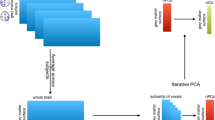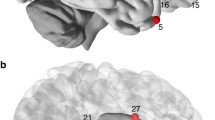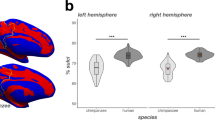Abstract
What changes in cortical organisation characterise global and localised variation between humans and chimpanzees remains a topic of considerable interest in evolutionary neuroscience. Here, we examined regional variation in cortical thickness, gyrification and white matter in samples of human and chimpanzee brains. Both species were MRI scanned on the same platform using identical procedures. The images were processed and segmented by FSL and FreeSurfer and the relative changes in cortical thickness, gyrification and white matter across the entire cortex were compared between species. In general, relative to chimpanzees, humans had significantly greater gyrification and significantly thinner cortex, particularly in the frontal lobe. Human brains also had disproportionately higher white matter volumes in the frontal lobe, particularly in prefrontal regions. Collectively, the findings suggest that after the split from the common ancestor, white matter expansion and subsequently increasing gyrification occurred in the frontal lobe possibly due to increased selection for human cognitive and motor specialisations.





Similar content being viewed by others
References
Amunts K, Zilles K (2006) A multimodal analysis of structure and function in Broca’s area. In: Grodzinsky Y, Amunts K (eds) Broca’s region. Oxford University Press, Oxford
Amunts K, Schleicher A, Bürgel U, Mohlberg H, Uylings HB, Zilles K (1999) Broca’s region revisited: cytoarchitecture and intersubject variability. J Comp Neurol 412(2):319–341
Armstrong E, Zilles K, Schleicher A (1993) Cortical folding and the evolution of the human brain. J Hum Evol 20:341–348
Bogart SL, Mangin JF, Schapiro SJ, Reamer L, Bennett AJ, Pierre PJ, Hopkins WD (2012) Cortical sulci asymmetries in chimpanzees and macaques: a new look at an old idea. Neuroimage 61:533–541
Brodmann K (1912) Neue Ergebnisse über die vergleichende histologische localisation der grosshirnrinde mit besonderer berücksichtigung des stirnhirns. Anatomischer Anzeiger Supplement 41:157–216
Changizi MA (2001) Principles underlying mammalian neocortical scaling. Biol Cybern 84:207–215
Dale AM, Fischl B, Sereno MI (1999a) Cortical surface-based analysis: I. Segementation and surface reconstruction. Neuroimage 9(2):179–194
Dale AM, Fischl B, Sereno MI (1999b) Cortical surface-based analysis: II. Inflation, flattening, and a surface-based coordinate system. Neuroimage 9(2):195–207
De Felipe J (2011) The evolution of the brain, the human nature of cortical curcuits and intellectual creativity. Front Neuroanat 5(29):1–17
Deacon TW (1997) The symbolic species: the coevolution of language and the brain. W. W. Norton and Company, New York
Desikan RS, Segonne F, Fischl B, Quinn BT, Dickerson BC, Blacker D, Buckner RL, Dale AM, Maguire RP, Hyman BT, Albert MS, Killany RJ (2006) An automated labeling system for subdividing the human cerebral cortex on MRi scans into gyral based regions of interest. Neuroimage 31:968–980
Fischl B, Dale AM (2000) Measuring the thickness of the human cerebral cortex from magnetic resonance images. Proc Natl Acad Sci 97(20):11050–11055
Fischl B, Sereno MI, Tootell RB, Dale AM (1999) High-resolution intersubject averaging and a coordinate system for the cortical surface. Hum Brain Mapp 8(4):272–284
Fischl B, Salat DH, Busa E, Albert M, Dietrich M, Haselgrove C, Avd Kouwe, Killiany R, Kennedy D, Klaveness S, Montillo A, Makris N, Rosen B, Dale AM (2002) Whole brain segmentation: automated labeling of neuroanatomical structures in the human brain. Neuron 33(3):341–355
Fischl B, Van Der Kouwe A, Destrieux C, Halgren E, Segonne F, Salat DH, Busa E, Seidman LJ, Goldstein J, Kennedy D (2004a) Auomatically parcellating the human cerebral cortex. Cereb Cortex 14(1):11–22
Fischl B, van der Kuwe A, Destrieux C, Halgren E, Segonne F, Salat DH, Busa E, Seidman LJ, Goldstein J, Kennedy D, Caviness V, Makris N, Rosen B, Dale AM (2004b) Automatically parcellating the human cerebral cortex. Cereb Cortex 14:11–22
Gomez-Robles A, Hopkins WD, Sherwood CC (2013) Increased morphological asymmetry, evolvability, and plasticity in human brain evolution. Proc R Soc B Biol Sci 280(1761):20130575
Holloway RL (2002) Brief communication: how much larger Is the relative volume of area ten of the prefrontal cortex in humans? Am J Phys Anthropol 118:389–401
Hopkins WD (2013) Behavioral and brain asymmetries in chimpanzees: a case for continuity. Ann N Y Acad Sci 1288:27–35
Hopkins WD, Nir T (2010) Planum temporale surface area and grey matter asymmetries in chimpanzees (Pan troglodytes): the effect of handedness and comparison within findings in humans. Behav Brain Res 208(2):436–443
Im K, Lee JM, Shin YW, Kim IY, Kwon JS, Kim SI (2006) Gender difference analysis of cortical thickness in healthy young adults with surface-based methods. Neuroimage 31:31–38
Kazu RS, Maldonado J, Mota B, Manger PR, Herculano-Houzel S (2014) Cellular scaling rules for the brain of Artiodactyla include a highly folded cortex with few neurons. Front Neuroanat 12(8):128
Keller SS, Highley JR, Garcia-Finana M, Sluming V, Rezaie R, Roberts N (2007) Sulcal variability, stereological measurement and asymmetry of Broca’s area on MR images. J Anat 211:534–555
Keller SS, Crow TJ, Foundas AL, Amunts K, Roberts N (2009a) Broca’s area: nomenclature, anatomy, typology and asymmetry. Brain Lang 109:29–48
Keller SS, Roberts N, Hopkins WD (2009b) A comparative magnetic resonance imaging study of the anatomy, variability and asymmetry of Broca’s area in the human and chimpanzee brain. J Neurosci 29:14607–14616
Keller SS, Deppe M, Herbin M, Gilissen E (2012) Variability and asymmetry of the suclal contours defining Broca’s area homologue in the chimpanzee brain. J Comp Neurol 520:1165–1180
Kevala I, Lewitus E, Huttner WB (2013) The secondary loss of gyrencephaly as an example of evolutionary phenotypical reversal. Front Anat 7(16):1–9
Kochunov PV, Glahn DC, Fox PT, Lancaster JL, Saleem KS, Shelledy W, Zilles K, Thompson PM, Coulon O, Mangin JF, Blangero J, Rogers J (2010) Genetics of primary cerebral gyrification: heritability of length, depth and area of primary sulci in an extended pedigree of Papio baboons. Neuroimage 53(3):1126–1134
LeRoy F, Cai Q, Bogart SL, Dubois J, Coulon O, Monzalvo K, Fischer C, Glasel H, Van der Haegen L, Benezit A, Lin CP, Kennedy DN, Ihara AS, Hertz-Pannier L, Moutard ML, Poupon C, Brysbaert M, Roberts N, Hopkins WD, Mangin JF, Dehaene-Lambertz G (2015) New human-specific brain landmark: the depth asymmetry of superior temporal sulcus. Proc Natl Acad Sci
Luders E, Narr KL, Thompson PM, Rex DE, Woods RP, DeLuca H, Jancke L, Toga AW (2006) Gender effects on cortial thickness and the influence of scaling. Hum Brain Mapp 27:314–324
McBride T, Arnold SE, Gur RC (1999) A comparative volumetric analysis of the prefrontal cortex in human and baboon MRI. Brain Behav Evol 54:159–166
Rabinowicz T, Dean DE, McFDonald-Comber J, Courten-Myers GM (1999) Gender differences in the human cerebral cortex: more neurons in males, more processes in females. J Child Neurol 14:98–107
Reader SM, Laland KN (2002) Social intelligence, innnovation, and enhanced brain size in primates. Proc Natl Acad Sci 99(7):4436–4441
Rilling JK (2006) Human and non-human primate brains: are they allometrically scaled versions of the same design? Evol Anthropol 15(2):65–77
Rilling JK, Insel TR (1999) The primate neocortex in comparative perspective using magnetic resonance imaging. J Hum Evol 37:191–223
Rilling JK, Seligman RA (2002) A quantitative morphometric comparative analysis of the primate temporal lobe. J Hum Evol 42:505–533
Rogers J, Kochunov PV, Zilles K, Shelledy W, Lancaster JL, Thompson P, Duggirala R, Blangero J, Fox PT, Glahn DC (2010) On the genetic architecture of cortical folding and brain volume in primates. Neuroimage 53:1103–1108
Schaer M, Cuadra M, Tamarit L, Lazeyras F, Eliez S, Thiran J (2008) A surface based approach to quantify local cortical gyrification. IEEE Trans Med Imaging 27(2):161–170
Schenker NM, Hopkins WD, Spocter MA, Garrison A, Stimpson CD, Erwin JM, Hof PR, Sherwood CC (2010) Broca’s area homologue in chimpanzees (Pan troglodytes): probabilistic mapping, asymmetry and comparison to humans. Cereb Cortex 20(3) :730–742
Schoenemann PT (2006) Evolution of size and functional areas of the human brain. Annu Rev Anthropol 35:379–406
Schoenemann PT, Sheehan MJ, Glotzer LD (2005) Prefrontal white matter volume is disproportionately larger in humans than in other primates. Nat Neurosci 8(2):242–252
Seldon SH (2005) Does brain white matter growth expand the cortex like a balloon? Hypothesis and consequences. Laterality 10(1):81–95
Semendeferi K, Damasio H (2000) The brain and its main anatomical subdivisions in living hominids using magnetic resonance imaging. J Hum Evol 38:317–332
Semendeferi K, Damasio H, Frank R, Van Hoesen GW (1997) The evolution of the frontal lobes: a volumetric analysis based on three dimensional reconstructions of the magnetic resonance scans of human and ape brains. J Hum Evol 32:375–388
Semendeferi K, Armstrong E, Schleicher A, Zilles K, Van Hoesen GW (2001) Prefrontal cortex in humans and apes: a comparative study of area 10. Am J Phys Anthropol 114:224–241
Semendeferi K, Lu A, Schenker NM, Damasio H (2002) Humans and great apes share a large frontal cortex. Nat Neurosci 5(3):272–276
Sherwood CC, Broadfield DC, Holloway RL, Gannon PJ, Hof PR (2003) Variability of Broca’s area homologue in great apes: implication for language evolution. Anat Rec 217A:276–285
Sherwood CC, Holloway RL, Semendeferi K, Hof PR (2005) Is prefrontal white matter enlargement a human evolutionary specialization? Nat Neurosci 8(5):537–538
Sherwood CC, Baurernfeind AL, Bianchi S, Raghanti MA, Hof PR (2012) Human brain evolution writ large and small. In: Hofman MA, Falk D (eds) Progress in brain research. Elsevier, Oxford
Stout D, Chaminade T (2012) Stone tools, language and the brain in human evolution. Philos Trans R Soc B Biol Sci 367:75–87
Uylings H, Jacobsen A, Zilles K, Amunts K (2006) Left–right asymmetry in volume and number of neurons in adult Broca’s area. Cortex 42(4):652–658
Van Essen DC (1997) A tension-based theory of morphogenesis and compact wiring in the central nervous system. Nature 385:313–318
Zilles K, Armstrong E, Moser KH, Schleicher A, Stephan H (1989) Gyrification in the cerebral cortex of primates. Brain Behav Evol 34:143–150
Zilles K, Palomero-Gallagher N, Amunts K (2013) Development of cortical folding during evolution and ontogeny. Trends Neurosci 36(5):275–284
Acknowledgments
This research was supported by NIH Grants MH-92923, NS-42867, NS-73134 and HD-60563 to WDH and National Center for Research Resources P51RR165 to YNPRC, which is currently supported by the Office of Research Infrastructure Programs/OD P51OD11132). American Psychological Association and Institute of Medicine guidelines for the treatment of chimpanzees in research were followed during all aspects of this study. NR is at The University of Edinburgh Clinical Research Imaging Centre (CRIC: http://www.cric.ed.ac.uk) which is part of the Scottish Imaging Network, A Platform for Scientific Excellence (SINAPSE) collaboration (http://www.sinapse.ac.uk/) that is funded by the Scottish Funding Council, Scottish Executive Chief Scientist Office, and the six collaborator Universities. NR is a member of the Centre for Cognitive Ageing and Cognitive Epidemiology (http://www.ccace.ed.ac.uk) part of the cross council Lifelong Health and Wellbeing Initiative, G0700704/84698). The MRI data for human subjects were acquired by Dr. Simon Keller at MARIARC, University of Liverpool. XL is supported by the T. J. Crow Psychosis Trust Fund.
Author information
Authors and Affiliations
Corresponding author
Electronic supplementary material
Below is the link to the electronic supplementary material.
Rights and permissions
About this article
Cite this article
Hopkins, W.D., Li, X., Crow, T. et al. Vertex- and atlas-based comparisons in measures of cortical thickness, gyrification and white matter volume between humans and chimpanzees. Brain Struct Funct 222, 229–245 (2017). https://doi.org/10.1007/s00429-016-1213-1
Received:
Accepted:
Published:
Issue Date:
DOI: https://doi.org/10.1007/s00429-016-1213-1




